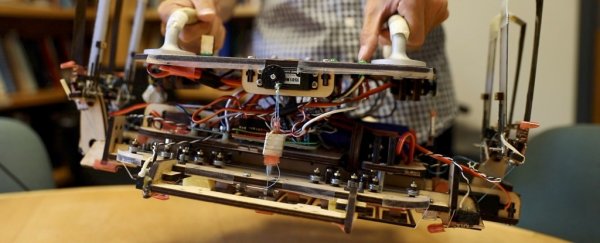Over the past 60 years, humans have successfully launched satellites, space vehicles and humans into Earth's orbit. We've also managed to leave a whole bunch of stuff floating up there that can destroy satellites in an instant.
Thankfully, researchers have designed a robotic gripper that can pick up the junk we've left behind on our space adventures. Taking design cues from gecko feet, the gripper's super clingy adhesive could enable climbing robots to carry out a range of tasks on a spacecraft, from checking and repairing defects to shooting videos.
"It's an outgrowth of work we started about 10 years ago on climbing robots that used adhesives inspired by how geckos stick to walls," says Mark Cutkosky, senior researcher on the team from Stanford University.
It is estimated that around 170 million pieces of debris are whizzing around Earth at over 28,000 kilometres per hour (17,500 miles per hour). In this whirling junkyard you will find blown apart satellites, bolts, shattered solar panels, and if you're lucky, frozen astronaut pee.
More than 20,000 pieces of this junk are larger than a softball, and an object doesn't have to be big to do damage. Space station windows have had to be replaced thanks to being scratched by paint flakes. And satellites are being lost each year due to colliding with accumulating debris, with manoeuvres also required to avoid potential impacts.
The trouble with keeping things tidy in space is that traditional methods aren't capable of doing the job in such extreme conditions. Suction cups require air pressure, sticky tape gets brittle in freezing temperatures and magnets can only work with magnetic objects.
Still, these challenges haven't stopped researchers from coming up with possible ways of managing the floating garbage, like debris harpoons. But because these methods often use force when making contact with an object, the debris ends up being pushed away.
But thanks to the gecko's uncanny climbing ability, researchers from Stanford University and NASA's Jet Propulsion Laboratory have developed an adhesive that can latch onto an object and dispose of it without using pressure.
 Kurt Hickman/Stanford News Service
Kurt Hickman/Stanford News Service
"If I came in and tried to push a pressure-sensitive adhesive onto a floating object, it would drift away," says Elliot Hawkes, one of the researchers from the University of California, Santa Barbara.
"Instead, I can touch the adhesive pads very gently to a floating object, squeeze the pads toward each other so that they're locked and then I'm able to move the object around."
The secret to the adhesive's clinginess is its microscopic flaps, which create a force between molecules when in contact with a surface. While not as complex, it works in the same way as the tiny bristles on a gecko's foot when climbing up a wall or clinging onto a ceiling.
The adhesive only becomes sticky when the flaps are pushed in a specific direction as a load is applied.
For sticking onto flat items like solar panels, the researchers arranged the adhesive squares in a grid formation on the front of the gripper robot. To grab hold of curved rocket bodies, the gripper uses the thin adhesive strips on its foldable arms to latch onto the object and move it towards its middle.
Each of the squares is also linked through a pulley system which can lock and unlock the pads. This means that the gripper can stick onto uneven surfaces, such as broken satellite parts.
 Kurt Hickman/Stanford News Service
Kurt Hickman/Stanford News Service
But to see whether the gecko gripper is really capable of cleaning up our mess in space, the team ran a series of rigorous tests.
In the Jet Propulsion Laboratory's Robodome, the gripper's first task was to capture and move another robot across a floor similar to a giant air-hockey table, which simulated a two-dimensional zero gravity environment.
With the adhesive pads attached to its arms, the gripper was able to capture and move its robotic opponent.
"We had one robot chase the other, catch it and then pull it back toward where we wanted it to go," says Hawkes. "I think that was definitely an eye-opener, to see how a relatively small patch of our adhesive could pull around a 300 kilogram robot."
Taking things up a notch, the researchers next tested how the gripper performed in zero gravity onboard the NASA's Weightless Wonder C-9B aircraft. Over two days, the aircraft made 80 ascents and dives to create weightlessness in the cabin.
Under these conditions, the gripper was able to grasp and release a cube, cylinder and large beach ball. The robot's movements were so gentle that the objects barely shifted when they were released.
Finally, the team developed handheld flat grippers for astronauts to test on the International Space Station. The gripper demonstrated the same adhesiveness as it did on ground and showed that it was durable enough to be left in place for several weeks at a time.
Now, the researchers will create a sturdier version of the gripper that can withstand the extreme temperatures and radiation outside of the space station.
The team hope to eventually produce large quantities of the gecko-inspired adhesive at a low cost, which could lead to it being used as widely as Velcro down here on Earth.
Thanks to the gecko, keeping our planet's orbit trash-free could be well within our reach after all.
The research was published in Science Robotics.
